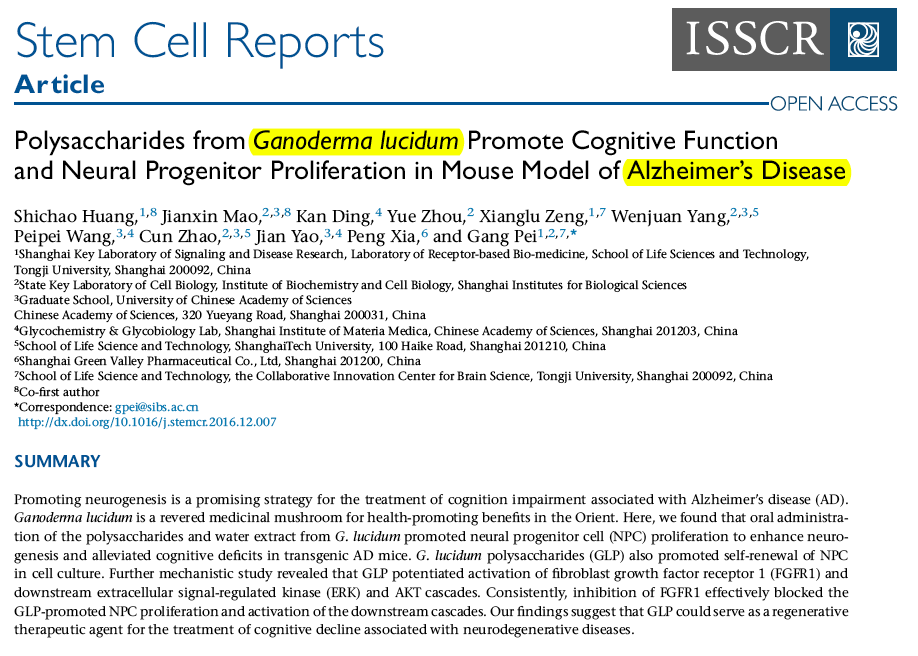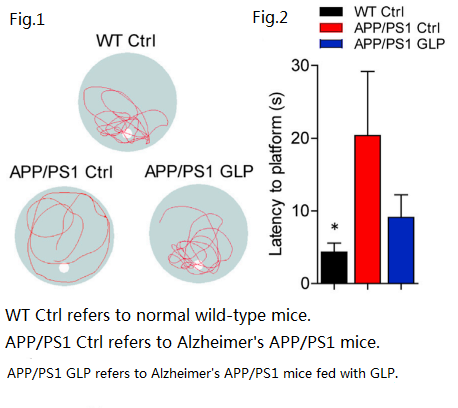Janvier 10, 2017 /Tongji University, Shanghai Institute of Materia Medica, Académie chinoise des sciences, etc.. / Rapports sur les cellules souches
Texte/Wu Tingyao

“Forget who you are and who I am” can be said to be the most typical symptom of Alzheimer’s disease. The reason for forgetting, or not being able to remember recent events, is that the nerve cells in charge of cognitive functions die bit by bit as the years go by, which makes an adult’s cognitive level continue to degenerate.
Faced with this increasingly prevalent Alzheimer’s disease, scientists are working hard to study feasible treatments. Some people focus on the culprit causing nerve cell death, trying to reduce the production of beta-amyloid protein; others are committed to promoting nerve cell regeneration, hoping to make up for the vacancy of nerve cell damage, which is perhaps the concept of “making it up if it is missing.”
In the mature mammalian brain, there are indeed two areas that continue to produce new nerve cells, one of which is in the hippocampal gyrus. These self-proliferating nerve cells are called “neural progenitor cells”. The cells newly born from them will be added to the original neural circuits to help learn new skills and form new memories.
Cependant, it can be observed in humans or mice that Alzheimer’s disease can disrupt the proliferation of neural precursor cells. Nowadays, more and more evidence points out that promoting the proliferation of neural precursor cells can reduce the cognitive deterioration caused by Alzheimer’s disease and may become a feasible strategy for the treatment of Alzheimer’s disease.
In January 2017, a study jointly published in “Stem Cell Reports” by Tongji University, Shanghai Institutes for Biological Sciences, Académie chinoise des sciences, etc., proved that polysaccharides or water extracts from Ganoderma lucidum(Champignon Reishi, Lingzhi) can alleviate cognitive impairment caused by Alzheimer’s disease, reduce the deposition of amyloid-β (Aβ) in the brain, and promote the regeneration of neural precursor cells in the hippocampal gyrus. The latter mechanism of action is likely to be related to the activation of a receptor called FGFR1 on neural precursor cells due to the regulation of Ganoderma lucidum.
Alzheimer’s mice that eatGanoderma lucidum have better memory.
The animal experiments in this study used 5 to 6-month-old APP/PS1 transgenic mice–that is, the use of gene transfer technology to transfer the mutant human genes APP and PS1 (which can induce hereditary early-onset Alzheimer’s disease) into the newly born mice for effective expression of the genes. This will make the brains of mice start to produce amyloid-β (Aβ) from a young age (after 2 months of age), and when they grow to 5-6 months of age, they will gradually develop difficulty in spatial recognition and memory.
In other words, the mice used in the experiment already had the initial symptoms of Alzheimer’s disease. The researchers fed such Alzheimer’s mice with GLP (pure polysaccharides isolated fromGanoderma lucidum spore powder with a molecular weight of 15 kD) à une dose quotidienne de 30 mg/kg (c'est, 30 mg per kilogram of body weight per day) pour 90 jours consécutifs.
Then, the researchers spent another 12 days testing the cognitive abilities of the mice in the Morris water maze (MWM) and compared them with those of mice with Alzheimer’s disease that had not received any medical treatment and with those of normal mice.
Mice have a natural aversion to water. When they are put in the water, they will try to find a dry place to rest. The “Morris Water Maze Test” uses their nature to set up a resting platform at a fixed location in a large circular pool. Since the platform is hidden under the water, the mice have to find it only by learning and remembering. Par conséquent, the researchers could judge whether the mice were getting dumber or smarter by the time the mice found the platform, the distance they swam and the path they took.
It was found that there was no significant difference in the swimming speed of mice in each group. But compared with normal mice, Alzheimer’s mice that had not received any treatment had to spend more time and swim longer distances to find the platform along a disordered path as if on luck, indicating that their spatial memory had been significantly impaired.
En revanche, Alzheimer’s mice fed with Champignon Reishi polysaccharides or Ganoderma lucidum water extract found the platform faster, and before finding the platform, they mainly wandered in the area (quadrant) where the platform was located, as if they knew the approximate location of the platform, indicating that the damage to their brain is less serious. 【Figure 1, Figure 2】
In addition, the researchers also observed in another experiment that for fruit flies that produce a large amount of amyloid-β (Aβ) in their brains (also through gene transfer methods to establish experimental models), Ganoderma lucidum water extract can not only improve the spatial recognition and memory abilities of fruit flies but also extend the lifespan of fruit flies.
The researchers also usedGanoderma lucidum extrait d'eau (300mg/kg par jour) in the above-mentioned animal experiments and found that it can also alleviate the spatial cognitive impairment caused by Alzheimer’s disease just like the aforementionedGanoderma lucidum polysaccharides (GLP).

Use the “Morris Water Maze Test” to evaluate the spatial memory ability of mice
[Chiffre 1] Swimming paths of mice in each group. The blue is the pool, the white is the platform position, and the red is the swimming path.
[Chiffre 2] The average time required for each group of mice to find a resting platform on the 7th day of the Morris water maze test
(Source/Stem Cell Reports. 2017 Jan 10;8(1):84-94.)
Lingzhi promotes the proliferation of neural precursor cells in the hippocampal gyrus.
After the 12-day water maze test, the researchers analyzed the brains of mice and found thatGanoderma lucidum polysaccharides etGanoderma lucidum water extracts both promote the regeneration of nerve cells in hippocampal gyrus and reduce amyloid-β deposition.
It was further confirmed that the newly born nerve cells in the hippocampus gyrus are mainly neural precursor cells. AndGanoderma lucidum is effective for Alzheimer’s disease mice. Feeding normal young adult mice withGanoderma lucidum polysaccharides(GLP) à une dose quotidienne de 30 mg/kg for 14 days can also promote the proliferation of neural precursor cells in the hippocampal gyrus.
In vitro experiments have also confirmed that for the neural precursor cells isolated from the hippocampal gyrus of normal adult mice or Alzheimer’s mice or the neural precursor cells derived from human stem cells, Ganoderma lucidum polysaccharides can effectively promote these precursor cells to proliferate, and the newly generated cells retain the original characteristics of neural precursor cells, c'est, they can perform proliferation and self-renewal.
Further analysis showed thatGanoderma lucidum polysaccharides (GLP) can promote neurogenesis mainly because they can strengthen a receptor called “FGFR1″ (not EGFR receptor) on neural precursor cells, making it more susceptible to the stimulation of “nerve growth factor bFGF”, which sends more information of “cell proliferation” to the neural precursor cells, and then more new nerve cells are born.
Since the newly born nerve cells can further join the existing neural circuits to function after they migrate to the brain area that needs it, this should alleviate a range of cognitive impairments caused by nerve cell death in Alzheimer’s disease.
The multi-faceted role ofGanoderma lucidum slows down the pace of forgetting.
The above research results let us see the protective effect ofGanoderma lucidum on nerve cells. In addition to its anti-inflammatory, anti-oxidant, anti-apoptotic, anti-β-amyloid deposition and other effects known in the past, Ganodermalucidum can also promote neurogenesis. For the Alzheimer’s mice that have the same genetic defects and are in the same symptoms, this is why the severity of the disease symptom is quite different between those who eatGanoderma lucidum and those who don’t eatGanoderma lucidum.
Ganoderma lucidum may not be able to completely restore memory function in Alzheimer’s patients, but its various mechanisms of action can slow down the deterioration of Alzheimer’s disease. As long as the patient remembers himself and others for the rest of his life, Alzheimer’s disease may not be so terrible.
[Source] Huang S., et autres. Polysaccharides from Ganoderma lucidum Promote Cognitive Function and Neural Progenitor Proliferation in Mouse Model of Alzheimer’s Disease. Rapports sur les cellules souches. 2017 Jan 10;8(1):84-94. est-ce que je: 10.1016/j.stemcr.2016.12.007.
FIN
À propos de l'auteur/Mme. Wu Tingyao
Wu Tingyao rapporte des informations de première main sur le Ganoderma depuis 1999. Elle est l'auteur deGuérir avec Ganoderma (publié dans The People's Medical Publishing House en avril 2017).
★ Cet article est publié sous l'autorisation exclusive de l'auteur.
★ Les œuvres ci-dessus ne peuvent pas être reproduites, extrait ou utilisé d’une autre manière sans l’autorisation de l’auteur.
★ Pour les violations de la déclaration ci-dessus, l'auteur assumera les responsabilités juridiques pertinentes.
★ Le texte original de cet article a été rédigé en chinois par Wu Tingyao et traduit en anglais par Alfred Liu.. S'il y a une divergence entre la traduction (Anglais) et l'original (Chinois), le chinois original prévaudra. Si les lecteurs ont des questions, veuillez contacter l'auteur original, MS. Wu Tingyao.



